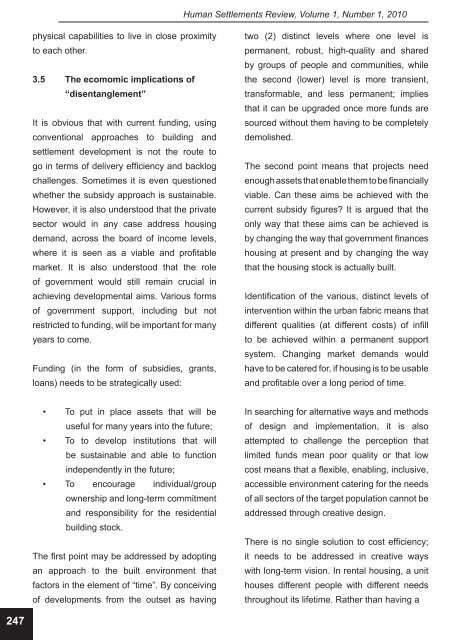Human Settlements Review - Parliamentary Monitoring Group
Human Settlements Review - Parliamentary Monitoring Group
Human Settlements Review - Parliamentary Monitoring Group
Create successful ePaper yourself
Turn your PDF publications into a flip-book with our unique Google optimized e-Paper software.
<strong>Human</strong> <strong>Settlements</strong> <strong>Review</strong>, Volume 1, Number 1, 2010<br />
physical capabilities to live in close proximity<br />
to each other.<br />
3.5 The ecomomic implications of<br />
“disentanglement”<br />
It is obvious that with current funding, using<br />
conventional approaches to building and<br />
settlement development is not the route to<br />
go in terms of delivery efficiency and backlog<br />
challenges. Sometimes it is even questioned<br />
whether the subsidy approach is sustainable.<br />
However, it is also understood that the private<br />
sector would in any case address housing<br />
demand, across the board of income levels,<br />
where it is seen as a viable and profitable<br />
market. It is also understood that the role<br />
of government would still remain crucial in<br />
achieving developmental aims. Various forms<br />
of government support, including but not<br />
restricted to funding, will be important for many<br />
years to come.<br />
Funding (in the form of subsidies, grants,<br />
loans) needs to be strategically used:<br />
two (2) distinct levels where one level is<br />
permanent, robust, high-quality and shared<br />
by groups of people and communities, while<br />
the second (lower) level is more transient,<br />
transformable, and less permanent; implies<br />
that it can be upgraded once more funds are<br />
sourced without them having to be completely<br />
demolished.<br />
The second point means that projects need<br />
enough assets that enable them to be financially<br />
viable. Can these aims be achieved with the<br />
current subsidy figures It is argued that the<br />
only way that these aims can be achieved is<br />
by changing the way that government finances<br />
housing at present and by changing the way<br />
that the housing stock is actually built.<br />
Identification of the various, distinct levels of<br />
intervention within the urban fabric means that<br />
different qualities (at different costs) of infill<br />
to be achieved within a permanent support<br />
system. Changing market demands would<br />
have to be catered for, if housing is to be usable<br />
and profitable over a long period of time.<br />
• To put in place assets that will be<br />
useful for many years into the future;<br />
• To to develop institutions that will<br />
be sustainable and able to function<br />
independently in the future;<br />
• To encourage individual/group<br />
ownership and long-term commitment<br />
and responsibility for the residential<br />
building stock.<br />
The first point may be addressed by adopting<br />
an approach to the built environment that<br />
factors in the element of “time”. By conceiving<br />
of developments from the outset as having<br />
In searching for alternative ways and methods<br />
of design and implementation, it is also<br />
attempted to challenge the perception that<br />
limited funds mean poor quality or that low<br />
cost means that a flexible, enabling, inclusive,<br />
accessible environment catering for the needs<br />
of all sectors of the target population cannot be<br />
addressed through creative design.<br />
There is no single solution to cost efficiency;<br />
it needs to be addressed in creative ways<br />
with long-term vision. In rental housing, a unit<br />
houses different people with different needs<br />
throughout its lifetime. Rather than having a<br />
247









![National Research Foundation Annual Report 2008 / 2009 [Part 2]](https://img.yumpu.com/49774036/1/177x260/national-research-foundation-annual-report-2008-2009-part-2.jpg?quality=85)







